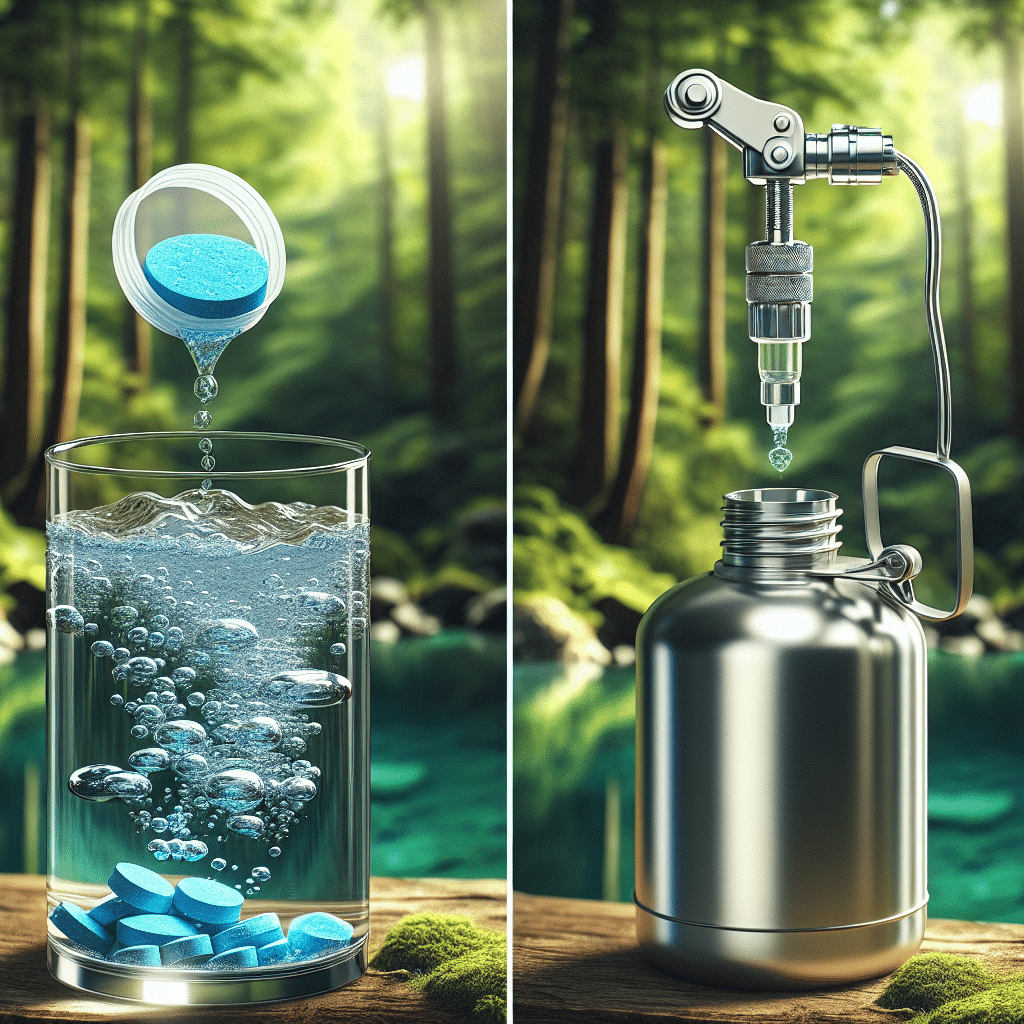Overview of Water Purification Methods
Water purification is crucial for outdoor enthusiasts, ensuring safe drinking water from various sources. Two primary methods for achieving this are chemical and mechanical purification. This article compares both, detailing their mechanisms, effectiveness, costs, and suitability for differing outdoor scenarios.
Chemical Water Purification
1. Mechanism of Action
Chemical purification employs agents such as chlorine, iodine, and water purification tablets that kill or deactivate pathogens. The chemicals work by disrupting the cellular processes of bacteria, viruses, and protozoa, rendering them harmless. For instance, chlorine oxidizes cellular components, leading to microbial death.
2. Types of Chemicals Used
- Chlorine: Widely used, chlorine solutions can purify large volumes of water. They are effective against bacteria and viruses but may not be reliable against protozoan cysts like Giardia.
- Iodine: Effective against a broad range of microorganisms, iodine is a popular choice among backpackers. However, it has limitations including prolonged exposure times and effectiveness against certain protozoa.
- Purification Tablets: These typically contain chlorine dioxide, which is effective against bacteria, viruses, and protozoa. Tablets are convenient and lightweight, making them ideal for camping and hiking.
3. Advantages
- Portability: Chemical purification tablets and liquids are lightweight and easy to carry.
- Cost-Effective: Chemicals are generally less expensive than mechanical systems.
- Long Shelf Life: Many chemical agents can be stored for years without losing efficacy.
4. Disadvantages
- Taste and Odor: Chemicals may impart a taste or odor to water, which can be unpalatable.
- Limited Effectiveness: Not all chemicals are effective against all pathogens, necessitating the need for some pre-filtering.
- Health Concerns: Prolonged consumption of iodine-treated water poses health risks, especially for those with thyroid issues.
Mechanical Water Purification
1. Mechanism of Action
Mechanical purification eliminates contaminants through physical barriers, such as filters that trap particles, bacteria, and larger microorganisms. The common types of mechanical systems include pumps, gravity filters, and straws.
2. Types of Mechanical Systems
- Pump Filters: These systems force water through a filter using a hand or foot pump. They are efficient and provide relatively quick access to purified water.
- Gravity Filters: Utilizing gravity to pull water through a filter, these systems are passive and require no pumping action. They are perfect for group camping scenarios.
- Straw Filters: These portable filters allow users to drink directly from a water source, filtering out bacteria and protozoa through a built-in mechanism.
3. Advantages
- Immediate Results: Mechanical systems provide instant access to purified water without waiting for chemical reactions.
- No Chemical Residue: Since they do not rely on chemicals, mechanical methods avoid any potential health risks associated with chemical ingestion.
- High Efficacy: Filters can effectively remove particles, bacteria, and protozoa, including Giardia and Cryptosporidium.
4. Disadvantages
- Bulk and Weight: Mechanical systems can be bulkier and heavier than chemical methods, especially pump systems.
- Filter Maintenance: Filters require maintenance and replacement, which can be a challenge in remote locations.
- Flow Rate Limitations: Some filters may have a slower flow rate than anticipated, resulting in longer wait times for purification.
Comparison of Efficiency and Effectiveness
When comparing the efficiency of chemical versus mechanical methods, it’s essential to consider the type of impurities commonly found in outdoor water sources. Chemical methods excel in treating viruses, but mechanical methods are generally more effective against a wider range of pathogens, particularly protozoa.
| Criteria | Chemical Purification | Mechanical Purification |
|---|---|---|
| Efficacy Against Pathogens | Good but limited for protozoa | Excellent against bacteria and protozoa |
| Time Required | Typically 30 minutes for chemicals | Immediate water access |
| Weight and Portability | Lightweight, portable | Can be bulkier but varies by type |
| Taste and Odor | May affect taste | No taste or odor issues |
| Maintenance | Minimal, just storage | Requires regular filter checks |
| Cost | Generally lower cost | Can be higher, depending on type |
Choosing the Right Method
The choice between chemical and mechanical water purification methods depends on several factors, including group size, water source, and personal preference.
1. Group Size and Consumption
For groups, gravity filters may be more suitable, as they can purify larger quantities of water without constant effort. Alternatively, individual hikers may prefer a portable straw filter for quick access.
2. Duration of Outdoor Activity
For short excursions, chemical tablets may be appropriate due to their ease of use and lightweight nature. However, for extended trips, investing in a reliable mechanical system could provide ongoing access to safe drinking water.
3. Water Source Quality
In areas known for high pathogen loads, mechanical filtration generally offers more comprehensive protection. Conversely, in regions with low risk, chemicals may suffice.
4. Environmental Considerations
If minimizing waste is a priority, mechanical filters may be more environmentally friendly, as they do not leave behind chemical residues. However, both methods are generally designed to adhere to principles of minimal environmental impact.
Conclusion
Both chemical and mechanical water purification methods offer distinct advantages and limitations for outdoor use. The decision should be tailored to the specific conditions and user preferences, ensuring safe drinking water regardless of location. By understanding the nuances of each method, enthusiasts can make informed choices and enjoy their outdoor adventures with confidence.
